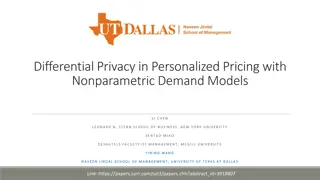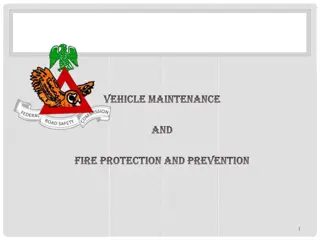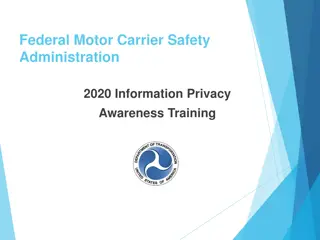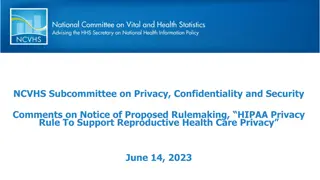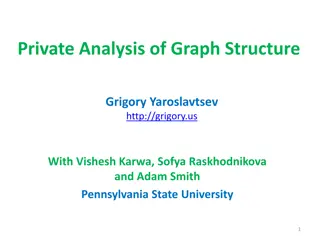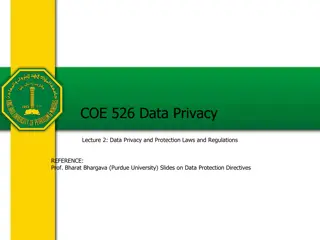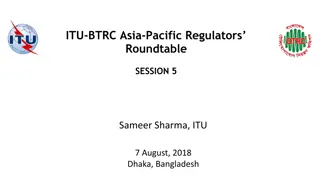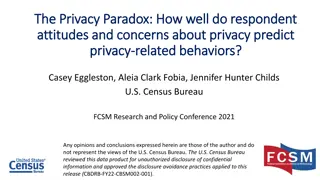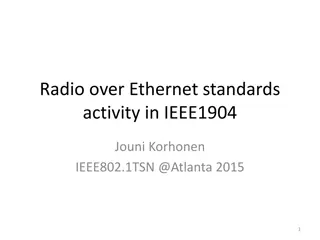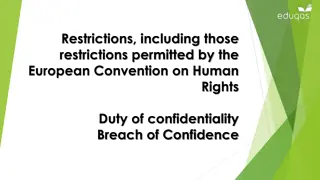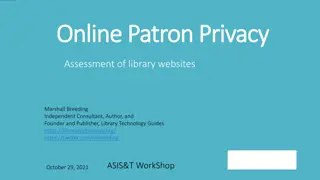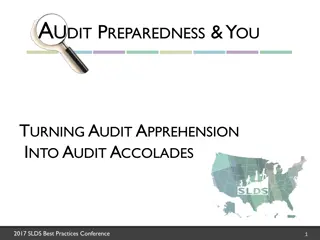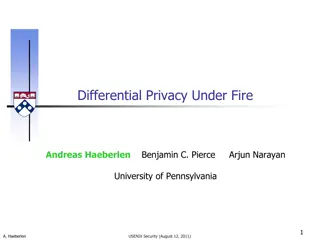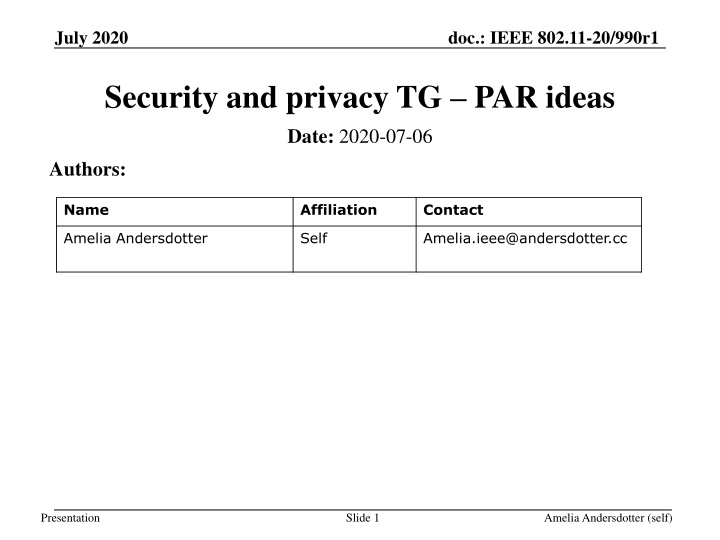
Enhancing IEEE 802.11 Security and Privacy Standards
Explore ideas for systematic, timely, and binding enhancements to IEEE 802.11 security and privacy standards. The presentation discusses the need for continuous monitoring and updates to address evolving security challenges within the standard. Consider various models to ensure the proactive resolution of security and privacy concerns, emphasizing the importance of structured processes to facilitate standard improvements.
Download Presentation

Please find below an Image/Link to download the presentation.
The content on the website is provided AS IS for your information and personal use only. It may not be sold, licensed, or shared on other websites without obtaining consent from the author. If you encounter any issues during the download, it is possible that the publisher has removed the file from their server.
You are allowed to download the files provided on this website for personal or commercial use, subject to the condition that they are used lawfully. All files are the property of their respective owners.
The content on the website is provided AS IS for your information and personal use only. It may not be sold, licensed, or shared on other websites without obtaining consent from the author.
E N D
Presentation Transcript
July 2020 doc.: IEEE 802.11-20/990r1 Security and privacy TG PAR ideas Date: 2020-07-06 Authors: Name Affiliation Contact Amelia Andersdotter Self Amelia.ieee@andersdotter.cc Presentation Slide 1 Amelia Andersdotter (self)
July 2020 doc.: IEEE 802.11-20/990r1 Abstract Security and privacy topics require a consistent, robust, and continuous method of making amendments or changes in the IEEE 802.11 standard, comparable with the ongoing work of TG Maintenance but acting on its own initiative rather than as a result of input from other TGs. This presentation considers different ways of achieving systematic, timely and binding security and privacy enhancements to IEEE 802.11 network technologies. Presentation Slide 2 Amelia Andersdotter (self)
July 2020 doc.: IEEE 802.11-20/990r1 Problem outline Security and privacy enhancements may require updates to the standard Security and privacy enhancements are not always foreseeable at the beginning of a standards amendment procedure; problems may be discovered as an amendment is being developed The existing process of pre-defining the scope of an amendment is not always sufficient to address security and privacy concerns in a timely fashion Different models can be envisaged to ensure the timely remedy of security and privacy considerations within the IEEE 802.11 standard: Presentation Slide 3 Amelia Andersdotter (self)
July 2020 doc.: IEEE 802.11-20/990r1 Problem outline (continuation) Defining one or several PARs for known, missing security or privacy features, for instance in the work of RCM SG. Ongoing PAR development in RCM SG could be a test case A standing committee (SC) as defined by the 802.11 Operations Manual section 6 Cannot introduce amendments to the standard on its own Is limited to giving recommendations to task groups on the resolution of security and privacy issues detected by or raised in the SC Introduces an additional, administrative step between the discovery of a security or privacy concern and its timely resolution However, also enables the continuous and systematic monitoring of security and privacy issues A Task Group (TG) as defined by the 802.11 Operations Manual section 4, similar to TGm Could perform similar functions to a Security and Privacy SC Would be empowered to create amendments to the standard Avoids the additional, administrative step of providing recommendations to actual task groups Presentation Slide 4 Amelia Andersdotter (self)
July 2020 doc.: IEEE 802.11-20/990r1 Current security and privacy work in TGs Currently, security and privacy modifications may be inserted into the standard in an ad hoc fashion TGM frequently discusses security and privacy topics and resolutions, including when they do not arise from the work of other task groups but, e.g., are brought to the WG:s attention by external parties (such as security researchers) Procedurally, this seems accepted by everyone involved, but could be argued to go above and beyond the actual mandate of TGM Again procedurally, it introduces a barrier between the IEEE 802.11 community and external privacy and security researchers that may otherwise be able to bring important insights to the community Task groups may raise security and privacy topics and resolutions at their own initiatives (e.g. LMR discussions in TGZ or MAC randomization discussions in TGAQ). In principle desirable and future initiatives in this area should not impede such work Presentation Slide 5 Amelia Andersdotter (self)
July 2020 doc.: IEEE 802.11-20/990r1 A security and privacy maintenance PAR Idea: let s set up a TG-SPM A security and privacy maintenance task group that deals with Security and privacy maintenance topics that are currently dealt with in TGM Emerging security and privacy maintenance topics Data privacy services as isolated subprojects Purpose of a TG-SPM To be able to define standards amendments independently of other task groups, ensuring the timely inclusion of security and privacy amendments to the standard Procedural basis for such a group TGM already exists, and its PAR is generic a TG-SPM PAR could be similar Challenge: subprojects would need to be specifically defined or enumerated, perhaps by continuous and ongoing PAR updates. It is likely that separate CSDs are needed for every subproject. Could make use of the purpose of a TG to produce supplements or portions of a draft standard in Operations Manual section 4.1: One main PAR to establish the TG-SPM which specifically allows the TG to produce sub-PARs for ad-hoc standards amendment projects for the TG-SPM. Sub-PARs would follow the same procedures as an SG-created PAR. Presentation Slide 6 Amelia Andersdotter (self)
July 2020 doc.: IEEE 802.11-20/990r1 Current TGM PAR (2017-03-28): http://www.ieee802.org/11/PARs/P802.11REVmd.pdf 5.2 Scope: The scope of this standard is to define one medium access control (MAC) and several physical layer (PHY) specifications for wireless connectivity for fixed, portable, and moving stations (STAs) within a local area. [[[NOTE: above is a very generic text]]]] 5.4 Purpose: The purpose of this standard is to provide wireless connectivity for fixed, portable, and moving stations within a local area. This standard also offers regulatory bodies a means of standardizing access to one or more frequency bands for the purpose of local area communication. [[[NOTE: above is a very generic text]]]] 5.5 Need for the Project: The reason for this project is to incorporate accumulated maintenance changes (editorial and technical corrections) into 802.11-2016, and roll up of approved amendments to the standard. The approved amendments as of the filing of the revision PAR include IEEE 802.11ah-2016 and IEEE 802.11ai-2016. Seven additional amendments are currently under development. [[[[NOTE: this is where the limitation of the task group s work is actually done i.e. rather than being in the scope or purpose of the PAR, limitation is accomplished through clarifying the projects need]]] Presentation Slide 7 Amelia Andersdotter (self)
July 2020 doc.: IEEE 802.11-20/990r1 Potential consequences for a TG-SPM PAR: 5.2 Scope: Could be made generic, i.e. The continuous and timely assessment of security and privacy applicability to the IEEE 802.11 standard or IEEE 802.11 standard amendments under development or formation. 5.4 Purpose: Could be made generic, i.e. ensure the timely inclusion of security and privacy enhancements into the IEEE 802.11 standard or, in cooperation with other task groups, IEEE 802.11 standard amendments under development. 5.5 Need for the Project: This is where limitation of the TG s activities would occur. It could e.g. consist in Providing an interface between security and privacy researchers with the IEEE 802.11 community Incorporate maintenance changes into the standard that are necessary to satisfy security and privacy concerns Ensure the establishment of specific standards project under the wings of the TG in cases where new features need to be introduced in the standard that go beyond mere maintenance items To be resolved: interfacing with other task groups in the IEEE 802.11 WG: what is a practical way for this do be done? Presentation Slide 8 Amelia Andersdotter (self)
July 2020 doc.: IEEE 802.11-20/990r1 TG-SPM interfaces with other Tgs: some ideas Close cooperation between TGM editor and TG-SPM editor potentially also on a TG chair level 5 min SPM coordination every CAC? (i.e. presentation of agenda, potential overlaps: puts a lot of burden on SPM chair, potentially) Roll up SPM approved changes into an amendment annually (some other time-period)? (to enable quick resolutions to urgent problem) Then pass to TGM as usual Make smaller amendments and pass to TGM? (maybe impractical with the balloting processes inside of WG and IEEE-SA at large) Presentation Slide 9 Amelia Andersdotter (self)
July 2020 doc.: IEEE 802.11-20/990r1 Teh end Questions/comments? Presentation Slide 10 Amelia Andersdotter (self)

